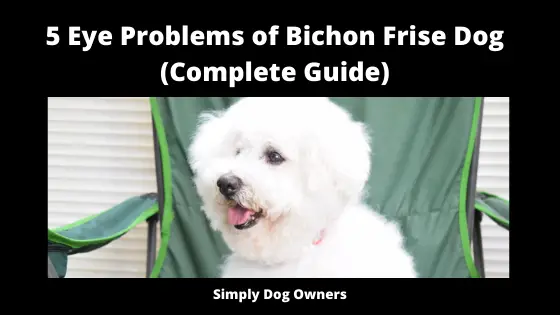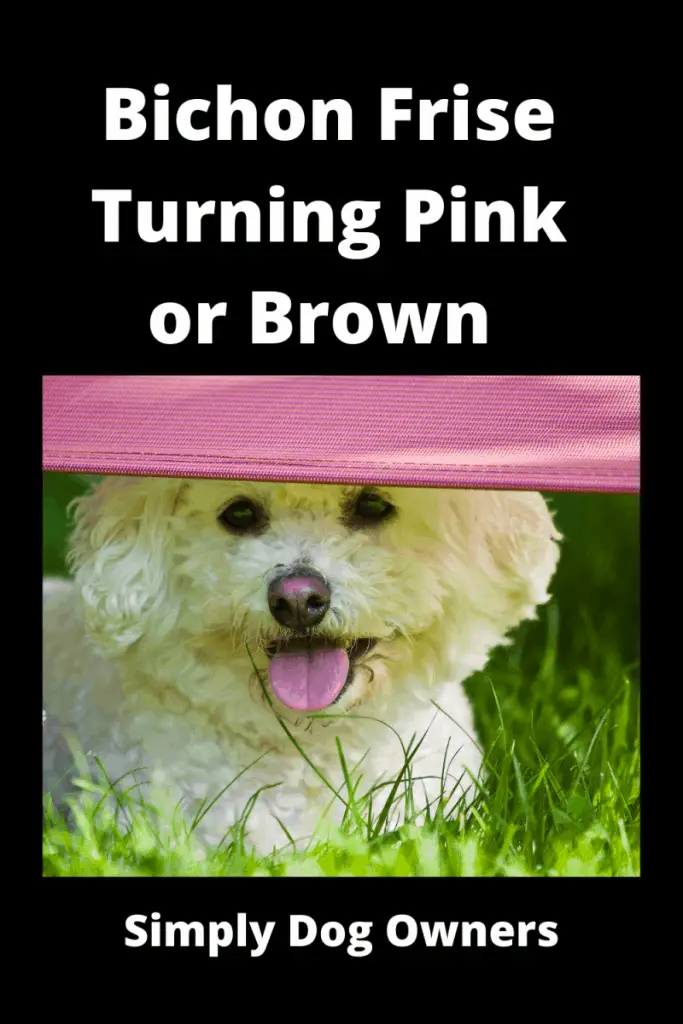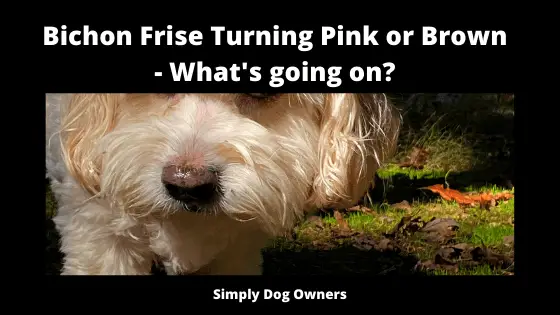Bichon Frise Turning Pink or Brown? Generally, a Bichon Frise Dog Breed is characterized by Black Noses and Pads on their feet, Their eyes are also black. They also can have pink or pink and blotched skin pigmentation.n Our Puppies were born with pink noses and paws. By 4-6 weeks their noses and paws had turned black and by 8 weeks their black Halos had formed.
Bichon Frise Brown
Several Reasons can point to this. Many times as the dogs mature we have seen their noses turn lighter grey, pink and or brown. This we feel has been due to the genetics of the parents. Same with their eyes being different colors than black.
We have also seen some of our dog’s noses / Fur on their noses change color due to health problems. Genetics is something you cannot change. A health problem can be addressed.
Bichon Frise Turning Pink or Brown / Why Bichon Frise Nose Turning Pink?
One of the most common causes of pink hair on a Bichon Fries is called yeast dermatitis, otherwise known as a yeast infection. All dogs, like people, have a healthy number of bacteria and fungus living on their skin.
Yeast infections occur when an overabundance of fungus is produced, which often results in itchiness and may cause a Bichon Fries to lick or scratch the area. A dog’s hair can take on a reddish hue as the result of a yeast infection thanks to the constant licking done to soothe irritation. This licking may exacerbate the problem further as yeast thrives in wet, humid areas.

While some redness is caused by skin issues, other examples may be typical of a certain dog, or even specific breeds. You’ve probably seen tear stains on the faces of Bichon Fries, which cause the hair just below the inner corners of the eyes to become brown or rust-colored.
These stains are caused by porphyrins, which contain iron molecules that a dog’s body passes through the urine, saliva, and tears. While most cases of tear staining occur as a result of healthy tear production, some may be the result of issues with the eyelid, like tightness in the medial canthal ligament.
Treatment Options for Pink Fur
In order to remove redness caused by a yeast infection, you’ll first need to identify the cause, which can be done with the help of a veterinarian. Because yeast infections are fungal infections, they are usually improved by topical treatments, like antifungal shampoo or ointment, or oral medication.
Sometimes, home remedies that rely on apple cider vinegar, which is a natural antifungal, can improve an infection, and the reddish stain on fur will go away over time. For dogs who have allergy-related infections, a dietary change may be in order, which can be done with the help of a doctor.
Having a dog with light fur is incredibly helpful for spotting illnesses like yeast infections or parasites as it can make the redness more easily visible, which will clue you into the issue relatively soon. This can also help you see where the issue is arising, which may clue you into the possible causes.
If you see your dog fur turning a rust color around the eyes, it’s recommended that you wash the area and dry it thoroughly. You can use a washcloth with warm water for mild cases, or if you make upkeep part of your regular routine, or you can try eyewash rinses and treatment pads, which are available at most pet stores.
Redness Prevention Tips
Pink dog fur staining is caused by either saliva or tears, the best way to keep your pet’s white fur looking light is to keep their skin clean and very dry. This goes for dogs with tear staining issues, and canines who have red or rusty paws, ears, or genitals from constant licking.
If your dog experiences frequent yeast infections on the paws or ears, you can try drying his feet after wet walks, and rubbing his ears dry after a bath or swim. For dogs with tear staining issues, keeping the hair around their eyes and nose as short as you can reduce discoloration.
Your dog’s diet, allergies, or a skin condition can cause him to lick excessively, creating pink fur stains. While he needs meat and bones, commercial foods consist of grains and fillers.
His saliva contains too much yeast and the bacteria stains his fur. Change his diet and consult a veterinarian, but clean the stains with a few household items.
- Pour the distilled water into the pitcher or large bottle. Add the sea salt, and shake or stir to mix thoroughly.
- Lead your dog into the tub or place him on a towel. The floor should not be carpeted to avoid damage.
- Saturate the pink fur stain with the saltwater solution; pour the mixture directly onto the stain and massage it into the fur for at least one minute. The salt works to kill the bacteria.
- Towel dry the affected area so that your dog’s fur is not dripping water.
- Soak the stained area with hydrogen peroxide. This can be poured directly from the bottle or applied with cotton balls. Massage the solution into the fur stain and allow it to remain for up to five minutes. Hydrogen peroxide works to bleach the stained fur.
- Rinse the stained area with warm water and towel dry your dog; allow his fur to air dry.
- Wash the stained area with the saltwater solution up to four times daily; however, bleach the spot with the hydrogen peroxide only once a day. Repeat until the stains disappear.
- Use caution if applying hydrogen peroxide to your dog’s face, such as around his mouth; it must not be splashed into his eyes.
- Your dog will need a higher protein diet to combat the yeast internally, or he will continue to lick and the pink stains will return.
- Consider commercial products such as whitening shampoo or wipes to help clear up the stains.
- Check with your veterinarian to make sure your dog doesn’t have allergies, dry skin, a sore or some other reason that could be causing the licking.
Why Is My Dog’s White Hair Turning Brown?
It’s natural for your dog’s white fur to undergo some discoloration. It’s not always possible for dogs to keep themselves perfectly clean, and things that would easily blend in on a brown-hair dog really stand out on a dog with white fur.
A dog’s white fur turning brown is not uncommon or serious. Use pet wipes to gently wipe the eye area and wipe around the mouth to remove food stains. It’s easier to prevent stains than to try to get rid of them once they start. A brown-hair dog or any dog with darker fur can benefit from these cleaning regimens too.
Any breed of white-furred dog can exhibit staining on the face from tears. The genetics that causes a dog to create excess tears can lead to more tear staining than another dog, even one from the same litter. The tear staining is due to a molecule in the tears called porphyrins.
Porphyrins contain iron and are produced when the body breaks down red blood cells. Molecules containing porphyrins are excreted through tears, saliva, and the pads of the feet. It is the iron in the molecules that causes the dark red or brown staining. These stains can get even darker if they are exposed to sunlight.
It can help to trim the hair at the corner of the eyes. This keeps tears from dripping down the face. Because saliva also contains porphyrins, a dog who chews on his leg or tail may also have his white fur turn brown or red.
Red yeast on Bichon Frise’s Fur
Besides porphyrins, red yeast (Pityrosporum) can also contribute to tear staining. If there are excessive tears, this moistness can encourage the growth of this type of yeast. If the cause of your dog’s white hair turning brown is yeast, you will notice an odor coming from the eye area.
The most common signs of a yeast infection on the skin of your dog are itching and redness, and odor, darkly pigmented skin, and flaky skin. This is the same type of yeast that can also cause ear infections.
For yeast that is recurrent or seems to be from a dog who always has a wet face, you can switch from a water bowl to a water bottle to keep the face drier. Yet another consideration is giving your dog distilled water to drink, as the iron in regular water can contribute to fur staining.

Keeping Fur White on Bichon Frise Dogs
When you brush your dog, sprinkle a little corn starch on her. Corn starch absorbs oils, covers up many stains, and removes odors. There are also some commercially available dog-whitening shampoos.
For serious stains, combine baking soda and water into a paste and then brush it into the stain. Let it dry and then wipe it off with a damp cloth. If the staining is from urine, try wiping your pet with a wipe right after urinating to keep the area clean. Apply full-strength shampoo on the spot, letting it sit for a few minutes before rinsing it.
The Bichon Frise is a dog with fluffy white fur. Keeping the face clean is the first line of defense against a dog’s white fur turning brown. Frequent washing with a mild shampoo can help, and you can use some commercially available cream products that go under the eyes to allow tears to roll down without soaking in. Vaseline also works for this.
We Gave our Dogs baths on Fridays, once a week. We used an Oatmeal Based Shampoo the most often. We also used whitening shampoos if they were really dirty. We use Non-Tearing shampoo to do their faces.
Top 10 Bichon Designer Breeds / Parents /Size / Video
| Designer Mix | Parents | Size | Video |
|---|---|---|---|
| Maltichon | Bichon / Maltese | Height / 8-11 inches Weight / 8 - 13 lbs | Maltichon |
| Bichpoo | Bichon / Poodle | Height / 9 - 14 inches Weight / 6 - 9 lbs | Bichpoo |
| Shichon | Bichon / Shih Tzu | Height / 9 - 12 inches Weight / 10 - 15lbs | Shichon |
| Yorkie Bichon | Bichon / Yorkie | Height / 9 - 12 inches Weight / 6 - 8 lbs | Bichon Yorkie |
| Chi Chon | Bichon / Chihuahua | Height / 8 - 10 Inches Weight / 6 - 10 Lbs | Chi Chon |
| Kashon | Bichon / Cairn Terrier | Height / 9 - 15 Inches Weight / 10 -18 Lbs | Kashon |
| Goldichon | Bichon / Golden Retriever | Height/15 - 20 inches Weight /20-40 Lbs | Goldichon |
| Chonzer | Bichon / Miniature Schnauzer | Height /10-16 inches Weight / 25-35 lbs | Chonzer |
| Glechon | Bichon / Beagle | Height /15-16 inches Weight / 15-35 lbs | Glechon |
| Corgi | Bichon / Corgi | Height /11-13 inches Weight / 31-37 lbs | Corgi |
Name - Link for Research
Parents - Breeds of Dogs
Size Height / Weight
Video - Video of the Bichon Designer Breed
Chart of Bichon Birthing Accessories
| Breeder Box | Do Not used Wired Dog cage |
| Heater | We use space heater for whole Room |
| scale | To Weigh Puppies make sure they are Gaining Weight |
| Clean towels | Chande during Birthing to clean up |
| Protected Space | Keep Mother away from other Dogs to avoid Distress |
| Draft Protection | Drafts can chill and kill a Puppy |
| Squash protection | Mothers can accidently squash a puppy |
| clean bedding | to replace after birth - will be wet |
| Seclusion | Needs her Privacy - she can get Hyper |
| Rubber Gloves | Keep things Clean and from Blood |
| Scisorrs & Thread | For Cutting Cord |
Puppy Birthing Complications
| Complications | Steps |
|---|---|
| If Unsure | Take to Vet If Time allows |
| Keep Mother Isolated | If Other dogs around she could get defensive and accidently Hurt Puppies |
| Puppy Accidentally Crushed | Make sure Not Giving Birth in Dog cage - puppies can work themselves through mesh and get Damaged |
| Not Breathing | Gently Give it Mouth to mouth |
| Not breathing | Massage Puppy trying to gently force fluid from his lungs |
| Puppy Stuck | Gently Pull |
| Puppy Breech | Help Guide legs out |
| Puppy Cold | Raise Enviorment to 85 degrees |
| Puppy Cold | Change Wet Bedding |
| Puppy Cold | Warm Puppy up put on Your body till body heat warms him |
| Puppy Cold | No drafts - No metal Floor Pan on Cage |
| Puppy not going on Nipple | Help Guide him to nipple till he gets hand of it |
| Puppy not feeding | Try Small baby Bottle let him suck - do not force him - can drown him with milk going in lungs |
| Puppy not feeding | Use puppy Milk Supplement |
| Puppy Not feeding | check for Cleft Palate |
| Puppy Not Feeding | Take to Vet - he can show you Catheter Feeding |
| Puppy Not Growing | Make sure Mother has plenty Food Water |
| Puppy Not Growing | You can check on scale |
| Labor stops or is prolonged over 24 hours | Take to vet - C section can save litter and Mother if needed |
| Mother does not Remove Membrane | You will Need to Manually remove it |
| Mother does not chew through Umbilical Cord | You will need to cut it 1/2 " away from puppies body tier with thread |
And Recommended Steps
Expense Table for Owning Bichons Frise
| Average Cost of AKC Puppy | Puppy Shots | Food | Grooming 4 / per year | Cage / Accessories / Bowls / Brushes / Leash / Collar | AKC - Registration Within 6 Months of Purchase | Micro Chip | Yearly Meds Heart Worm Worming | Dog License | Total Investment | Puppies Possible / Year |
|---|---|---|---|---|---|---|---|---|---|---|
| $ 450 - No Breeding Rights | $ 120 | $ 10 / Wk High Quality Food | $ 45 ea / $180 Yr | Cage - $50 Rest - 50 | $ 35 | $ 45 - One Time Cost By Vet | Heart Worm Meds - $60 / Yr Worming - $ 30 / YR | $ 35 / Yr | $ 1575 / Dog | 1-6 Puppies Average 3 |
| $ 750 - $ 950 Puppy with AKC Papers and No Restrictions | Total Investment | |||||||||
Breeds Descended from Water Dogs
| Name of Breed | Country of Origin |
|---|---|
| American Water Spaniel | United States |
| Barbet | France |
| Cantabrian Water Dog | Spain |
| English Water Spaniel | England |
| Irish water Spaniel | Ireland |
| Lagotto Romagnoio | Italy |
| Poodle | Germany |
| Portuguese Water Dog | Portugal |
| Pudelpointer | Germany |
| Spanish water Dog | Spain |
| Tweed water Spaniel | England |
| Wetterhoun | Netherlands |
Bichon Frise Resource Links
| Bichon Frise Club of America | United States | Link |
|---|---|---|
| Bichon Frise AKC | United States | Link |
| Bichon Frise United Kennel Club | UK | Link |
